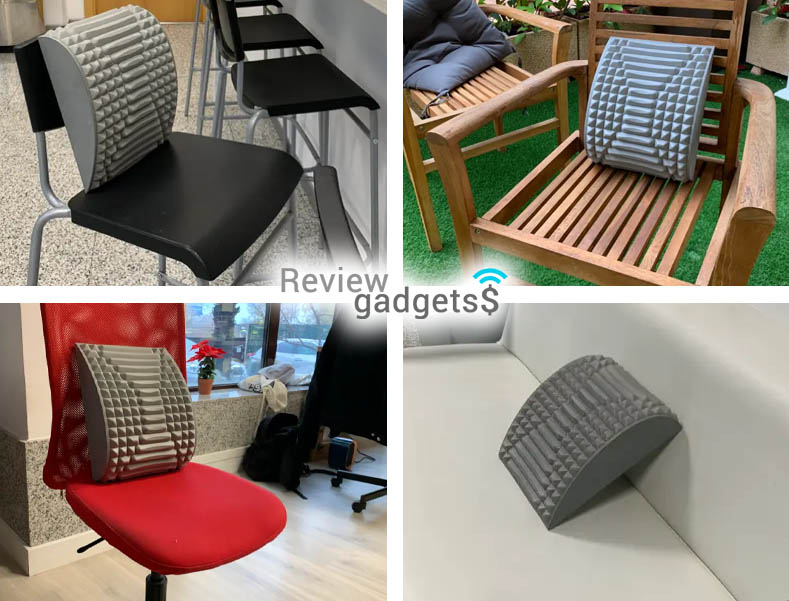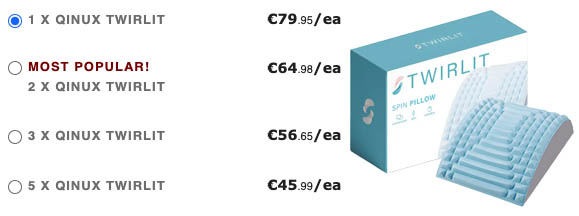I’m not a physical therapist, but I spend way too many hours sitting in front of a laptop. Between meetings, video editing, and writing, my lower back complains daily. That’s why I decided to try Qinux Twirlit, a tear-drop shaped lumbar pillow designed to stretch, decompress, and align your spine in short sessions.

I’ve used it for two weeks, at home and at the office. Here’s my full review: what I liked, what I’d improve, and most importantly, who it’s actually for.
What exactly is it?
Qinux Twirlit is a lumbar stretch pillow made of EVA + TPE (dense, springy foam). It measures 31 × 25 × 10.5 cm and comes in three colors (grey, pink, blue). The drop-shape creates a central channel that guides your spine’s natural curve, while the raised edges hug the paraspinal area. The idea: lie your back on the support for 10 minutes, twice a day to relax muscles, reduce pressure, and encourage a more neutral posture.
Beyond the lower back, the maker suggests variations: gentle neck support, leg elevation, or even foot massage. It’s not a medical treatment, but it targets a clear niche: people with discomfort from sitting, poor posture, or long workdays.
Design & Materials: Minimalism with intent
The finish is understated and tough. The EVA here is firm (it doesn’t collapse right away) yet keeps a touch of cushioning so pressure doesn’t feel sharp. No covers or moving parts: wipe it with a damp cloth and you’re done. The central groove is well executed; when you lie back, your vertebrae “seat” naturally, avoiding that “foam roller” effect that sometimes presses into the sore spot instead of offloading it.
Portability was a nice surprise: it fits in a large backpack, weighs little, and takes up less room than a strap-on seat cushion. For remote work on the go or anyone switching home–office, it’s convenient.
How does Twirlit work?
In simple terms: Twirlit redistributes load. Lying down on it, the pressure hotspot your lower back gets from sitting is spread out thanks to the tear-drop shape; at the same time, tissues around the spine get a gentle, sustained stretch. There’s no “cracking” or manipulation feeling: it’s a progressive glide, almost like your back can breathe again.
Used on the neck (placed higher up and gently), the channel helps avoid hyper-extension; placed under the knees, it unloads the posterior chain. It’s not a miracle, but it breaks the cycle of tension → pain → poorer posture.

Test protocol (real 14 days)
- Week 1: 10 min mornings + 10 min evenings, lying on a yoga mat. Lower-back focus.
- Week 2: add 5–7 min neck and leg elevation at day’s end. Extra trials on sofa and on a medium-firm mattress.
- Context: 6–8 h sitting/day, breaks every 50–60 min, no changes to chair or desk.
Day-by-day experience
- Days 1–3: immediate change in stiffness. I finish the day with less “tug” in the low back. Getting up after each session, I feel a warm, pleasant glow (a sign of blood flow and relaxation).
- Days 4–7: morning tightness drops a notch or two. In the evening session, the stretch feels deeper without turning uncomfortable. Heads-up: if the peak sits right under a hypersensitive spot, pressure can be too much; shifting it 2–3 cm changes everything.
- Days 8–10: tried the neck: soft support, no hyper-extension. Result: less trap load after laptop work.
- Days 11–14: consolidation. End-of-day fatigue clearly drops, and I’m sleeping more smoothly (fewer tosses) if I do a 7–10 minute night session.
Does it ease pain? What really changes?
For me, yes: less stiffness when getting up, fewer sharp twinges at day’s end, and quicker recovery after long editing sessions. It won’t solve things if I then slouch for four hours straight, but it breaks the accumulated-tension loop.
For the neck, it worked as a gentle unload: nothing aggressive, just lengthening the upper back a bit. Under the knees, it relaxes the hamstrings and gives the low back a breather while watching a show.
Price & Special Offers
Looking for a simple way to stretch, decompress, and realign your lower back after long hours sitting? Qinux Twirlit is available with a launch deal offering 50% off and free shipping. Thanks to this promo, you can get it for €49.95 instead of €99.90 .
The offer is time-limited and stock-dependent. If you work daily on a laptop, edit video, or study for long stretches, Twirlit can become your 10-minute reset—no fuss.
Activate the 50% discount via this link
How to buy
- Check availability on the official website via this link.
- Choose the quantity of Qinux Twirlit and your color (grey, pink, or blue).
- Enter your details for shipping and payment to complete a secure purchase.
- Enjoy the limited-time promo and get your Twirlit delivered to your door.
Purchase Guarantee
For peace of mind, Qinux Twirlit includes a 30-day satisfaction guarantee. If for any reason it doesn’t meet your expectations, you can request a refund with no hassle. Use it daily during the first weeks and notice the shifts: less stiffness, better bounce-back after long days, and a gradual sense of relief without aggressive “cracks.”
Other users’ opinions
With 1,400+ verified reviews and an average TrustScore of 4.6 out of 5, Qinux Twirlit has become a favorite among people who sit for hours and want a short routine to decompress the lower back. Here are the most representative comments I found online:
Ellen Parker ★★★★☆ (4.7/5)
“I work 8–9 hours at the computer and used to finish with my lower back on fire. With Twirlit I do two 10-minute sessions (morning and afternoon) and stiffness clearly drops. I like that it doesn’t sink and that the center channel lets my back ‘slot in’ by itself. I carry it to the office in my backpack no problem.”
James Carter ★★★★☆ (4.6/5)
“I tried foam rollers, but they felt too intense. Twirlit is kinder and more guided: you lie down, breathe, and the pressure spreads without pounding the tissue. Tip: moving it 3 cm totally changes the feel. I do wish it came with a washable cover.”
Laura Bennett ★★★★★ (4.9/5)
“In video editing I sit for hours. The Twirlit routine has broken the tension → pain → bad posture loop. I also use it for a few neck minutes and to raise my knees at the end of the day. I toss and turn less if I do a night session.”
Daniel Walker ★★★★☆ (4.8/5)
“I came from classic lumbar cushions that only fill space; they don’t stretch. Twirlit actually mobilizes when you lie down. On the sofa it loses precision; on a mat or medium-firm mattress it’s spot on. Great value for money.”
Quick comparison with alternatives
- Classic lumbar cushions: good while seated, but they don’t stretch—they just fill and support. Twirlit actually mobilizes tissues when you lie down.
- Foam rollers: more intense and versatile, but require technique; overdo it and you’ll “stun” the muscle. Twirlit is gentler and more guided.
- Braces or posture correctors: they “fix” posture at the cost of dependence. Twirlit trains your body to find neutral without squeezing.
- Physio sessions: irreplaceable for serious injuries or specific diagnoses. Twirlit doesn’t compete with that; it’s a low-cost daily hygiene tool.
Usage tips that worked for me
- Short and frequent: better 10 minutes twice a day than 30 in one go.
- Breathing: 4–6–8 cycles (inhale 4 s, hold 6 s, exhale 8 s) to help your body “let go.”
- Fine-tuning: moving the support one or two centimeters shifts the pressure zone and sensation.
- Surface: floor with a mat or a medium-firm mattress; it loses precision on a sofa.
- After each session: walk 2–3 minutes and drink water; it helps integrate the stretch.
Safety & common sense
Qinux Twirlit is non-invasive and portable, but if you have acute pain, tingling, loss of strength, a diagnosed herniation, or a recent injury, check with a pro first. The goal isn’t to force your back—it’s to support it. If something hurts (sharp pain, burning), stop and reposition or shorten the session.
What I liked vs. what could improve
Liked: the tear-drop curve, the stability (it doesn’t “sink”), the portability, and the fact it needs no apps or batteries. At the promo price, the value is obvious compared to a single physio session in many cities.
Could improve: I’d love a washable fabric cover included and a small booklet with illustrated routines (neck, lumbar, legs) for different profiles: office, runners, gamers, etc. I’d also like to see it on more retailers like Amazon, not just the official site.
Who is it for?
- People who sit for many hours (office, editing, gaming) and feel recurring lower-back tension.
- Anyone who wants a short 10-minute routine morning/night to reset their back without complicated gadgets.
- Users toggling between office and home who need a compact tool.
If you have a complex clinical picture or pain that radiates down the legs with loss of strength, prioritize a professional assessment and use Twirlit—if appropriate—as a complement.
Activate the 50% discount via this link
Frequently Asked Questions (FAQ)
How long should I use Qinux Twirlit each day?
The base recommendation is 10 minutes, twice daily (morning and evening). If you’re starting out, begin with 5–7 minutes and increase gradually. The key isn’t a marathon session—it’s consistency.
What surface works best?
A mat on the floor or a medium-firm mattress. On a sofa it can lose precision as you sink in. Try small position tweaks to find the sweet-spot offload.
Is it also for the neck?
Yes—with gentle, controlled use. Place Twirlit higher so the channel prevents hyper-extension. Start with 2–4 minutes, breathe slowly (e.g., 4–6–8), and stop if you feel sharp pain.
Can I use it if I have a herniation or acute pain?
If you have acute pain, tingling, loss of strength, a diagnosed herniation, or a recent injury, consult a health professional first. Qinux Twirlit is a postural-hygiene tool, not a medical treatment.
How is it different from a foam roller?
A roller is more intense and technical; overdoing it can leave muscles “stunned.” Twirlit is gentler: it redistributes load and guides the lumbar curve with its tear-drop shape, encouraging a sustained stretch.
And versus a seat cushion?
A cushion supports while you sit, but it doesn’t stretch or mobilize. Twirlit works while you’re lying down, promoting decompression and a neutral posture—ideal for a reset after long hours.
How soon will I feel something?
Many people notice less stiffness within the first 2–3 days. More consistent changes usually come from week two with daily use.
Is there a size or weight/height limit?
Twirlit is one-size (31 × 25 × 10.5 cm). It works across different body types because the offload relies on micro-adjustments (shift the support 1–2 cm) and your chosen surface.
How do I clean and maintain it?
No covers or moving parts. Wipe with a damp cloth and mild soap; air dry. Avoid harsh cleaners. Tip: let it air out the first time to dissipate any light foam smell.
Can I combine it with exercise or physio?
Yes. It often enhances gentle routines (mobility, breathing, walks) and complements physiotherapy. If your pro gave you specific guidance, follow it.
Activate the 50% discount via this link
Is it normal to feel “warmth” when I get up?
Yes—that’s usually a sign of circulation and local relaxation. You shouldn’t feel sharp pain or a burning sensation. If you do, reposition, shorten the session, or change the surface.
Can I use it for legs or feet?
Also yes. Under the knees it helps unload the hamstrings and ease the lower back; as a plantar support it provides a gentle massage after a long day.
Can I take it to the office or when traveling?
Yes, it’s lightweight and fits in a large backpack. Use it during breaks or when you get home to break the day’s inertia.
Does it come with a cover or different densities?
Currently it’s a balanced single density with no fabric cover included. Many users would love a washable cover and a soft/firm option—keep an eye out if these appear on the official site.
What should I do right after a session?
Walk 2–3 minutes and drink water. That helps integrate the stretch and keep that lightness feeling.
Take the opportunity to get your Qinux Twirlit and build a quick, effective, back-friendly habit.
Verdict
Qinux Twirlit isn’t trying to be a “magic cure” for back pain, but as a daily tool to mobilize, stretch, and offload the lumbar area, I’m convinced.
Its smart design, well-tuned density, and simplicity make it easy to form a habit—and that’s where the real power is.
If your back needs a break and you want something effective, portable, and affordable, this lumbar pillow is a very sensible buy.






